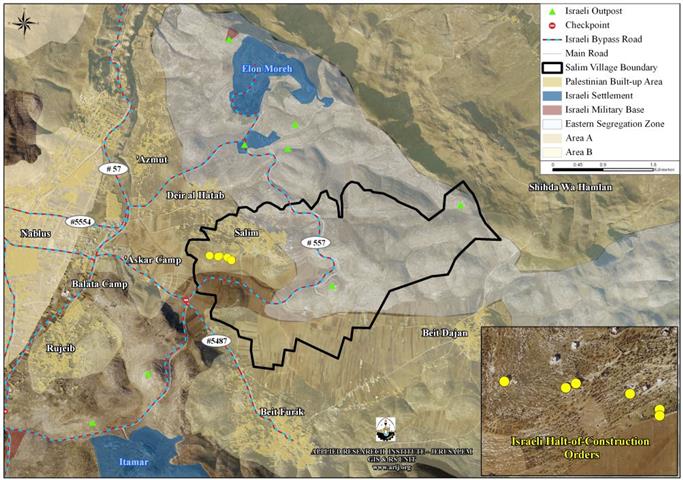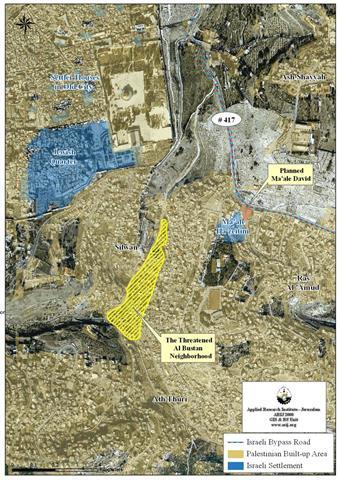On August 17, 2009, the Israeli Army handed 17 Palestinian local residents from Salem village military orders notifying them that their houses will be demolished under the pretext of lacking building permits. It is worth mentioning that the targeted houses located in Area “C” where the Palestinians has to apply for a building permits from the Israeli Civil Administration to build on their own lands, and their requests most often rejected. The following are some of the names of the owners of the threatened houses:
1. Mr. Ramez Sabri Shtayyeh
2. Mr. Rami ‘Abed Ibrahim Shtayyeh
3. Mr. Wadee’ Ghaleb Mohammad
4. Mr. Raed Fathi Salim Heidar
5. Mr. Murad Fathi Salim Heidar
6. Mr. Muhtasib Hilmi Karaki
7. Mr. Zaher Hussein Jabbour
8. Mr. Mohammad Nabil Shtayyeh
Mr. Mus’ab Abdel Khaleq Jabbour
Map 1: Some of the Palestinian houses that are threatened
to be demolished in Salem Village
Salem, a Palestinian village located 4.46 km east of Nablus city and stand approximately 530 meters above the sea level. The village’s population is about 4986 according to the latest survey conducted by the Palestinian Central Bureau of Statistics (PCBS 2008), the village spread on an area of 10294 dunums, 3134 dunums of which classified as area B and 7160 classified as area “C” (according to Oslo II Agreement – Interim Agreement- of 1995 which signed by the Palestinian Liberation Organization PLO and Israel).
Salem village sets next to Deir Al Hatab village from the north and the Illegal Israeli settlement of Elon Moreh (along with its 2 outposts) from its far North, Beit Furik from the south, Balata refugee camp as well as Rujeib village from the west and the village of Beit Dajan from the east. Table 1 below shows the Illegal Israeli outposts which are located within the village boundary of Salem village:
|
Outpost Name
|
Closest Mother Settlement
|
Date of Est.
|
Population
|
|
Skalis Farm, Point 972
|
Elon Moreh
|
Jan. 1999
|
20
|
|
Elon Moreh South
|
Elon Moreh
|
Jan. 2002
|
NA
|
|
Source: ARIJ GIS Database 2009
|
Salem village like the rest of the Palestinian villages and towns in the occupied Palestinian Territory has undergone harsh measures either at the hands of Israeli Army or Israeli settlers from the nearby Israeli settlement (Elon Moreh) varying from Land confiscation, to uprooting of fruitful trees and other harassments.
Salem village is an agricultural community in that the majority of its lands (39%) are classified as arable lands where a wide variety of Fruitful trees are cultivated, most Old Roman Olive trees. Furthermore, the village is famous for its field cultivations where about 18% of its lands are utilized for that purpose. Moreover, only 35% of the village’s lands are classified as open spaces and fall within Area ‘C’ where the Israeli enjoy absolute control over land. The open spaces are the only area available for the village to expand and develop in the future. See Table 2
Table 2: Land Classification of Salim Village – Nablus
|
Land Classification
|
Area (Dunums)
|
|
Agricultural Lands
|
5920
|
|
Forests & Open Spaces
|
3955
|
|
Palestinian built-up area
|
396
|
|
Israeli Outpost
|
23
|
|
Total Area
|
10294
|
|
Isolated Land (Eastern Segregation Zone) – Under Israeli Control
|
6412
|
|
Source: ARIJ GIS Database 2009
|
To Conclude
The Israeli colonial practices in the occupied Palestinian Territory aim to let he Palestinians and the rest of the world know that they are still in control of the land and of what is happening on the ground, which is another side of the Israel’s relentless efforts to impose facts on the ground and in case of Salem village, the Israelis are aiming to accelerate the eviction of the Palestinian people out from their houses and lands emphasize their control over area C and to guarantee the future expansion of the adjacent Illegal Israeli settlements which surrounds the village from all sides.
Moreover, the Israeli demolition of the Palestinian houses contradicts with the International law rules and conventions such as:
-
Article 147 of the Fourth Geneva Convention indicated that: Extensive destruction and appropriation of property not justified by military necessity and carried out unlawfully and wantonly, is a grave breach of the Convention.
-
Article 53 of the same convention provides that ‘any destruction by the Occupying power of real or personal property belonging individually or collectively to private persons, or to the State, or other public authorities or social or cooperative organizations is prohibited, except where such destruction is rendered absolutely necessary by military operations.’
-
Art. 23 of the Hague Convention of 1907 also provides: In addition to the prohibitions provided by special Conventions, it is especially forbidden to destroy or seize the enemy’s property, unless such destruction or seizure be imperatively demanded by the necessities of war.















